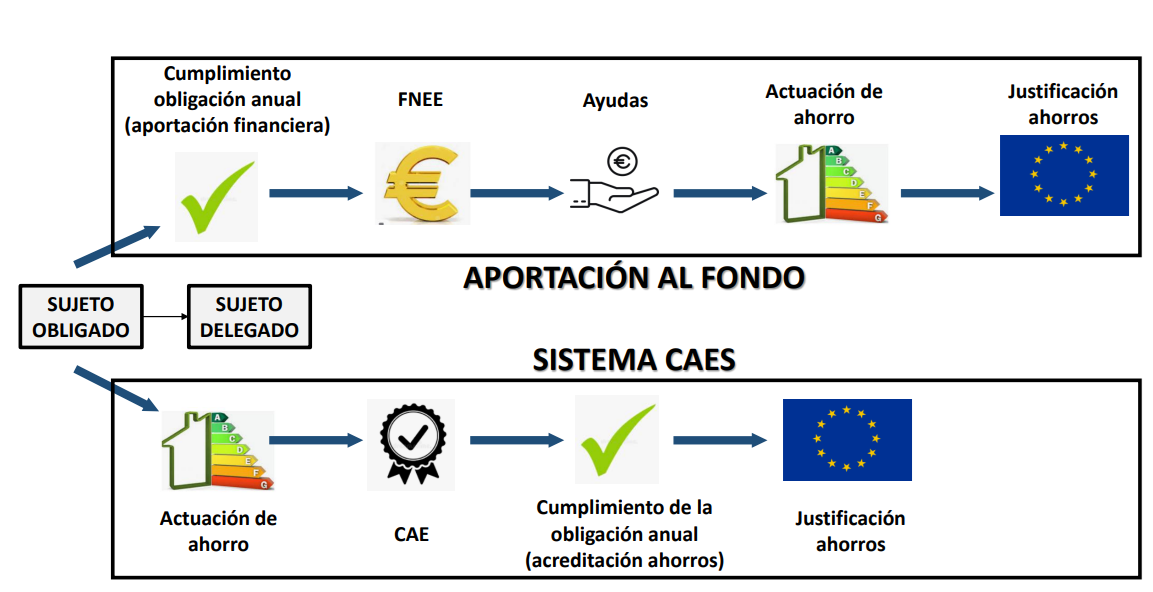For years, EU countries such as Italy and France have been using so-called white certificates as instruments for financing energy efficiency measures and renewable energy projects. Under the name Certificados de Ahorro Energético (CAE), such a financing mechanism is now also being promoted in Spain. Under the CAE system, companies with energy-saving obligations, such as energy suppliers and traders, can meet their obligations by purchasing certificates for energy efficiency improving measures or renewable energy projects from private households or other companies. Solar thermal is one of the eligible technologies.

Source: Presentation of MITECO
On July 18, 2024, the Ministry of Ecological Transition and Demographic Challenge (MITECO) updated its catalogue of energy efficiency measures that can be certified. In addition to the installation of heat networks and heat pumps, it now also mentions solar thermal energy as an eligible technology for contributing to the decarbonization of air conditioning in buildings. According to MITECO, applications for certification for installations with a savings potential of more than 196,000 MWh/year have been made since the CAE system was introduced in November 2023. This corresponds to the energy consumption of around 60,000 households. MITECO expects that energy-saving investments of more than EUR 41 billion can be certified by 2030.
Utilities can cover up to 65 % of their energy saving obligations by purchasing CAE certificates
“The Spanish Certificados de Ahorro Energético (CAE) system was inspired by the French Certificats d’Économies d’Énergie (CEE),” explains Antonio J. Ruiz, CEO of the consulting company Bettergy. At the end of June 2024, Bettergy was one of seventeen companies that joined forces to form the National Association of Delegated Subjects in order to participate in the trading of CAE energy-saving certificates.
In general, Ruiz considers the white certificates to be a direct response to the requirements of the EU Energy Efficiency Directive (EED), which encourages the governments of EU countries to take legal measures to save energy and reduce pollutant emissions. In Spain, the CAE system is an element of the National System of Energy Efficiency Obligations (SNOEE) as is the National Energy Efficiency Fund (FNEE). Since 2020, energy suppliers and traders, as so-called obligated entities, have had to demonstrate annual energy savings or pay financial equivalents into the FNEE. The CAE system now offers them the alternative option of covering up to 65% of their energy saving obligations or equivalent payments by purchasing CAE certificates, which gives them certain financial advantages over paying into the FNEE.
“Private households as well as commercial and industrial companies can use the CAE system. Due to the system’s technology neutrality, solar thermal energy can also benefit from it,” said Ruiz. The Bettergy CEO believes that solar thermal energy should receive a positive boost from the CAE system. How beneficial it will be depends on how the savings generated by these systems are quantified and evaluated within the CAE structure, he said.
“The revenues from selling CAEs depend on the annual savings generated by the solar thermal system, but are estimated to cover 20 % of the investment costs,” explained Pascual Polo, General Secretary of the Spanish solar thermal association ASIT Solar. He wants so support ASIT´s members in using the CAE system. “To begin with, we have signed an agreement with Bettergy that gives our members special conditions and makes it easier for them to manage, acquire and use CAEs”, explained Polo. A web platform will be made available to the ASIT group for the calculation, registration and subscription of CAEs generated by installation companies, a process with which they will be assisted by qualified professionals.
“Compared to other EE measures such as building insulation or the use of efficient home appliances, the adoption of solar thermal systems under CAE will depend on the relative cost-effectiveness and ease of implementation of these systems,” said Ruiz.
The CAE system should not only help homeowners to implement energy efficiency measures in their homes, commercial developers of industrial projects should also benefit from it, he hopes. This is especially true for large renewable energy plants that generate significant energy savings. For his company, Bettergy, the aim is to explain the complicated regulations of the CAE system to potential users. To this end, agreements will be made with installer associations, workshops organized and brochures published.
“As one of the leading companies in this field, we offer our clients personal advice on the potential benefits of CAE and support their application process. We have already developed digital tools for scaling up energy efficiency and CAEs,” added Ruiz.